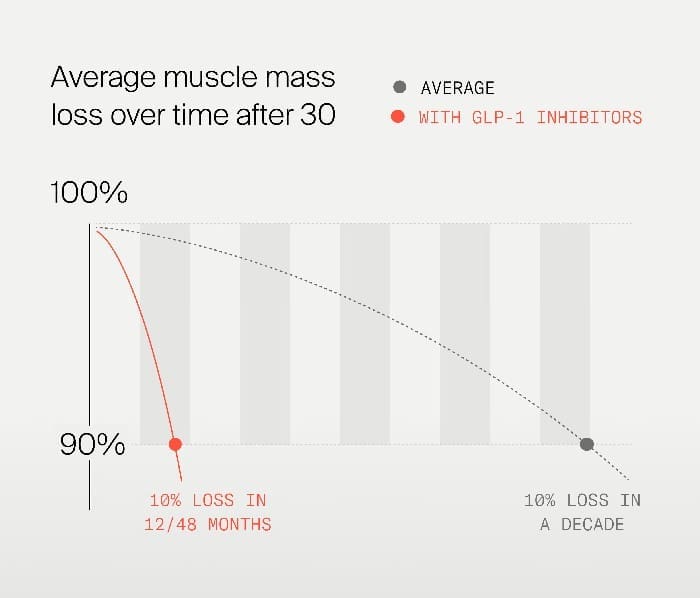By Kassia Garfield, MaxStrength Fitness
GLP-1 (glucagon-like peptide-1) receptor agonists—like semaglutide (Ozempic, Wegovy) and liraglutide (Saxenda)—are making headlines for their impressive weight-loss effects. Initially designed to manage type 2 diabetes, these medications are now widely prescribed for weight management. But amid the excitement, a critical yet often overlooked issue is emerging: muscle loss.
While the pounds may drop quickly on GLP-1s, a significant portion of that weight can come from lean muscle mass. This hidden consequence carries serious implications—not just for physical performance, but also for long-term health, bone density, metabolic function, and even joint stability.
Why Muscle Loss Happens on GLP-1s
GLP-1 medications work by suppressing appetite, slowing gastric emptying, and changing insulin secretion. These effects help people eat less and lose weight. However, when calorie and protein intake are reduced—especially alongside rapid weight loss—the body can break down muscle tissue for energy.
Clinical studies show that 25% to 40% of the weight lost on GLP-1 medications may come from lean mass, including muscle. This is concerning because muscle isn’t just about strength or appearance—it plays a crucial role in nearly every aspect of health. 40% muscle loss is like not getting out of bed for 2 weeks!
Unfortunately, many people don’t realize how vital muscle is for independent living, injury prevention, metabolic resilience, and even reducing joint pain by supporting proper alignment. Plus, once muscle is lost, it’s challenging to rebuild—it takes time, consistency, and effort.

Why Muscle Mass Matters
Maintaining muscle is essential for:
Bone Health: Muscle contractions place mechanical stress on bones, stimulating bone growth and maintaining bone density. Losing muscle accelerates bone loss, increasing the risk of osteoporosis and fractures—especially in older adults.
Metabolic Health: Muscle tissue is a primary site for glucose disposal and insulin sensitivity. Less muscle can lead to poorer blood sugar control and a higher risk of insulin resistance.
Mobility and Daily Function: Muscle supports balance, posture, and movement. Loss of muscle mass can lead to frailty, falls, and a reduced ability to live independently.
Longevity: Higher levels of muscle mass and strength are strongly associated with reduced risk of chronic disease and longer lifespan.
How Strength Training Can Help
The good news? Muscle loss is not inevitable—even on GLP-1 medications. Strength training (also called resistance training) is one of the most effective ways to preserve or build muscle. It works by stimulating muscle fibers to grow in response to stress from weights, resistance bands, or bodyweight exercises.
People who include strength training during weight loss tend to lose more fat and less muscle, improving their overall body composition. Bonus: building muscle also helps reduce loose skin by filling out the space beneath it.
Key Recommendations:
Lift Weights 2–3 Times per Week: Prioritize heavy resistance. If you’re not challenging your muscles, you’re not triggering adaptation. Progressive overload is key.
Eat Enough Protein: Aim for .7-1.0 grams per pound of ideal body weight per day to support recovery and growth.
Start Early: Begin strength training at the start of your GLP-1 journey. Don’t wait until muscle loss has already occurred.
Conclusion
GLP-1 receptor agonists are powerful tools for weight loss and diabetes management—but they aren’t without downsides. Muscle loss is a hidden risk that can impact your health, functionality, and longevity if left unaddressed.
By combining these medications with resistance training and smart nutrition, you can protect your muscle mass, safeguard your bones and joints, and ensure your weight loss is not only effective—but truly healthy. If you are on these medications and not actively strength training (walking does not count!) you are losing muscle!
Practical Tips to Get Started
If you’re new to strength training or unsure where to begin, here are a few steps that can help:
Hire a Certified Personal Trainer: Especially in the beginning, a professional can teach proper form, build a customized program, and help prevent injuries. Look for trainers with experience in strength training and, ideally, familiarity with medical weight loss or GLP-1 users.
Start Small but Stay Consistent: You don’t need to lift heavy weights right away. Start with bodyweight exercises or resistance bands and gradually increase the intensity.
Use a Program or App: If hiring a trainer isn’t an option, there are plenty of reputable strength training apps and programs designed for beginners. Look for evidence-based programs with progressive overload built in.
Join a Group Class or Gym: Sometimes the motivation and structure of a community can make all the difference. Classes like strength circuits, small group training, or supervised lifting sessions can be effective and supportive.
Track Your Progress: Whether through strength benchmarks, body composition tracking, or how your clothes fit, monitoring your progress keeps you motivated and focused.
Here at MaxStrength Fitness of Niceville we specialize in one on one, high intensity resistance strength training. If you need help on your journey, please give us a call at 850-373-4450 for a free demo workout and consult!































































